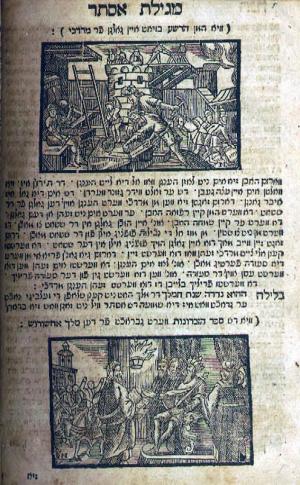Obj. ID: 35512
Jewish printed books Tzeena u-Reena by Ya'akov ben Yitzhak me-Yanov, Amsterdam, 1792

This text was prepared by William Gross:
Most Jewish women of the 17th and 18th centuries were unable to read Hebrew, but were familiar with Yiddish. At the same time almost all editions of the Bible were published in Hebrew. There arose a popular literature of Bible stories for women in the Yiddish language. This book was named "Tzeena u-Reena" and was published in many editions, particularly in Southern Germany.
This book is a miscellany of Midrashic tales and exegetical commentary, woven around a Yiddish rendering and paraphrasing of the Chumash, Haphtaroth and the Megillot. The Tzeena u-Reena is the most renowned Yiddish work of homiletical prose and has been particularly beloved by generations of Jewish women. Written in a lucid, flowing style, the numerous editions issued over time has resulted in that the text of the book has become a laboratory in researching the development of the Yiddish language.
The book was often illustrated with charming woodcuts to keep the interest of the readers. Illustrated Tzeen u-Reena books illustrated by woodcuts were less common in Holland than in Germany where numerous editions were published in Suzbach, Fuerth and Frankfurt a.M.
Yochanan Lefi Rofe was the son of printer Naftali Hertz Levi Rofe, who operated an Ashkenazic press in Amsterdam beginning in 1726. In 1770 Yochanan set up his own press in partnership with his brother-in-law Baruch and Baruch's brother. They printed in partnership (mostly prayerbooks) until 1786. Later, in 1788-1793, the press was operated by Yochanan and Baruch alone. From 1789 they printed catalogues of books for sale. From 1797 to 1827, the press operated under the ownership of Yochanan and his son Binyamin.
EJ; M. Erik, Geshikhte fun der Yidisher Literatur (1928), 223–30; Milly Heyd, “Illustrations in Early Editionms of the tsene-u’Rene”, Jewish Art X 1984 pp. 64-86; JE; Ch. Lieberman, in: Yidishe Shprakh, 26 (1966), 33–38; 29 (1969), 73–76; Ch. Shmeruk, in: For Max Weinreich on his Seventieth Birthday (1964);












